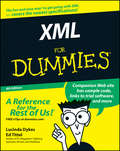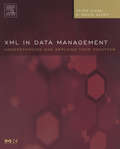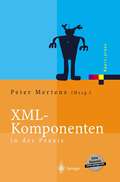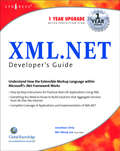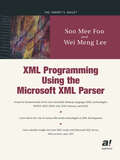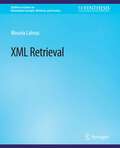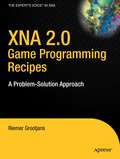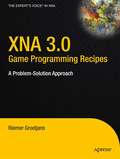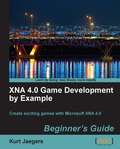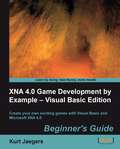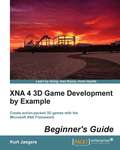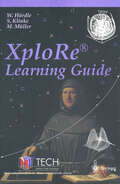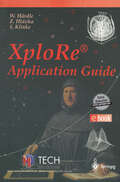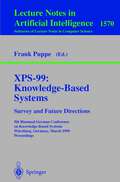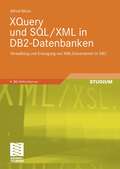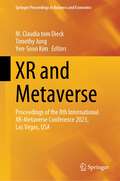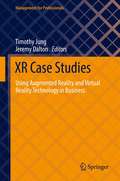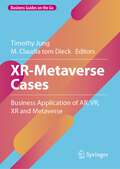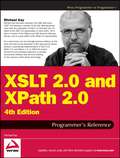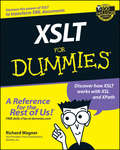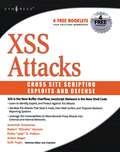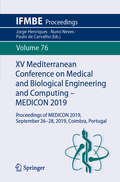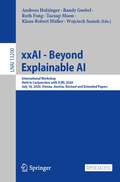- Table View
- List View
XML For Dummies
by Lucinda Dykes Ed TittelSee how XML works for business needs and RSS feeds Create consistency on the Web, or tag your data for different purposes Tag -- XML is it! XML tags let you share your format as well as your data, and this handy guide will show you how. You'll soon be using this markup language to create everything from Web sites to business forms, discovering schemas and DOCTYPES, wandering the Xpath, teaming up XML with Office 2003, and more. Discover how to * Make information portable * Use XML with Word 2003 * Store different types of data * Convert HTML documents to XHTML * Add CSS to XML * Understand and use DTDs
XML in Data Management: Understanding and Applying Them Together (The Morgan Kaufmann Series in Data Management Systems)
by Peter Aiken M. David AllenXML in Data Management is for IT managers and technical staff involved in the creation, administration, or maintenance of a data management infrastructure that includes XML. For most IT staff, XML is either just a buzzword that is ignored or a silver bullet to be used in every nook and cranny of their organization. The truth is in between the two. This book provides the guidance necessary for data managers to make measured decisions about XML within their organizations. Readers will understand the uses of XML, its component architecture, its strategic implications, and how these apply to data management.Takes a data-centric view of XMLExplains how, when, and why to apply XML to data management systemsCovers XML component architecture, data engineering, frameworks, metadata, legacy systems, and moreDiscusses the various strengths and weaknesses of XML technologies in the context of organizational data management and integration
XML Net Developers Guide
by SyngressCompete with the big players in today's E-commerce marketplaceElectronic Data Interchange (EDI) has long been the standard for large business enterprises to communicate in the B2B marketplace. However, EDI is a difficult technology - the cost and support of EDI standards is often too much for a small or medium business enterprise to bear. To compete in the current E-commerce marketplace, many organizations are beginning to take an interest in the interoperability that exists between XML (Extensible Markup Language) and EDI. XML .NET Developers Guide is written for information technology professionals responsible for supporting data management in both small and large organizations. This book appeals to both individuals working with an existing EDI environment, and small to medium businesses looking to increase their market presence by competing with current EDI players using XML/EDI.XML/EDI is quickly becoming an industry standard, however there is a noticeable lack of quality reference material for programmers looking to adopt these standards.You can take it with you. The book comes with Syngress' revolutionary Wallet CD containing a printable HTML version of the book, all of the source code, and demo versions of popular XML/EDI translation tools Up to the minute web-based support with solutions@syngress.com
XML Programming Using the Microsoft XML Parser
by Wei-Meng Lee Soo Mee FooXML Programming Using the Microsoft XML Parser is written for programmers interested in XML development using Microsoft technologies. Coupling valuable discussion of the Microsoft XML parser, Windows platform, and XML development software with the numerous core XML technologies, including XSLT, XPATH, SAX, DOM, XML Schema, and SOAP, this book steps beyond the mainstream focus on the theoretical aspects of XML and actually demonstrates the concepts in a real-world development environment. Veteran authors and trainers Soo Mee Foo and Wei Meng Lee intersperse this survey of XML technologies with discussion of topics sure to interest any budding XML developer, providing timely information regarding Web services, ActiveX Data Objects (ADO), and Microsoft SQL Server 2000 XML support. A chapter is also devoted to the Wireless Markup Language (WML), one of the most visible applications of XML technology. No question, XML is one of the rising stars in information technology. XML Programming Using the Microsoft XML Parser offers you what you need to know to get acquainted with the concepts necessary to begin development with this exciting technology.
XML Retrieval (Synthesis Lectures on Information Concepts, Retrieval, and Services)
by Mounia LalmasDocuments usually have a content and a structure. The content refers to the text of the document, whereas the structure refers to how a document is logically organized. An increasingly common way to encode the structure is through the use of a mark-up language. Nowadays, the most widely used mark-up language for representing structure is the eXtensible Mark-up Language (XML). XML can be used to provide a focused access to documents, i.e. returning XML elements, such as sections and paragraphs, instead of whole documents in response to a query. Such focused strategies are of particular benefit for information repositories containing long documents, or documents covering a wide variety of topics, where users are directed to the most relevant content within a document. The increased adoption of XML to represent a document structure requires the development of tools to effectively access documents marked-up in XML. This book provides a detailed description of query languages, indexing strategies, ranking algorithms, presentation scenarios developed to access XML documents. Major advances in XML retrieval were seen from 2002 as a result of INEX, the Initiative for Evaluation of XML Retrieval. INEX, also described in this book, provided test sets for evaluating XML retrieval effectiveness. Many of the developments and results described in this book were investigated within INEX. Table of Contents: Introduction / Basic XML Concepts / Historical Perspectives / Query Languages / Indexing Strategies / Ranking Strategies / Presentation Strategies / Evaluating XML Retrieval Effectiveness / Conclusions
XNA 2.0 Game Programming Recipes: A Problem-Solution Approach
by Riemer GrootjansIn this book, XNA expert Reimer Grootjans brings together a selection of the hottest quick-start recipes in XNA programming for the Xbox and Windows PC. Advanced XNA programmers, experienced coders new to games development, and even complete beginners will find XNA Game Programming Recipes an invaluable companion when building games for fun or as commercial products. Numerous problem-solving recipes cover topics from cameras and angles, to textures, models, and lighting and shadowing, and will get you over the common hurdles encountered in both 2D and 3D XNA application design.
XNA 3.0 Game Programming Recipes: A Problem-Solution Approach
by Riemer GrootjansJoin the game development revolution today! XNA 3.0 greatly simplifies the development of your own games, lowering the barrier for programmers to get into game development. In XNA, you can start coding your games from the very start, a true revelation compared to other game programming environments. XNA doesn't sacrifice power for this ease of use—it is built entirely on DirectX technology. Completely updated for XNA 3.0, expert Riemer Grootjans brings together a selection of the hottest recipes in XNA programming for the Xbox 360, PC, and Zune. Advanced XNA programmers, experienced coders new to game development, and even complete beginners will find XNA 3.0 Game Programming Recipes an invaluable companion whether building games for fun or as commercial products.
XNA 4.0 Game Development by Example: Beginner's Guide
by Kurt JaegersThis book is a step-by-step tutorial that includes complete source code for all of the games covered. It adopts an engaging style to teach all the game development concepts. Each block of code is explained, and game development concepts are diagrammed and covered in detail. Each game begins with a concept description and concludes with suggestions for expanding on the finished game. If you are an aspiring game developer who wants to take a shot at creating games for the Microsoft Windows platform with the XNA Framework, then this book is for you. Using this book, you can get started with creating games without any game development experience. A basic knowledge of C# would be helpful to kick-start your game development, but it's not essential.
XNA 4.0 Game Development by Example: Beginner's Guide - Visual Basic Edition Beginner's Guide
by Kurt JaegersIn DetailXNA Game Studio enables hobbyists and independent game developers to easily create video games, and now gives that power to Visual Basic developers. XNA lets you bring your creations to life on Windows, the Xbox 360 and the Windows Phone platforms. The latest release of XNA has added support to Visual Basic and therefore, Visual Basic developers now have the power to give life to their creativity with XNA.This book covers both the concepts and the implementations necessary to get you started on bringing your own creations to life with XNA. It presents four different games, including a puzzler, space shooter, multi-axis shoot 'em up, and a jump-and-run platformer. Each game introduces new concepts and techniques to build a solid foundation for your own ideas and creativity.This book details the creation of four games, all in different styles, from start to finish using Visual Basic and the Microsoft XNA framework. Beginning with the basics of drawing images to the screen, the book then incrementally introduces sprite animation, particles, sound effects, tile-based maps, and path finding. It then explores combining XNA with Windows Forms to build an interactive map editor, and builds a platform-style game using the editor-generated maps. Finally, the book covers the considerations necessary for deploying your games to the Xbox 360 platform.By the end of the book, you will have a solid foundation of game development concepts and techniques as well as working sample games to extend and innovate upon. You will have the knowledge necessary to create games that you can complete without an army of fellow game developers at your back.A step-by-step tutorial for using Visual Basic with Microsoft XNA to create four different styles of video games.ApproachThis book is a step-by-step tutorial that includes complete source code for all of the games covered. It adopts an engaging style to teach all the game development concepts. Each block of code is explained, and game development concepts are diagrammed and covered in detail. Each game begins with a concept description and concludes with suggestions for expanding on the finished game.Who this book is forIf you are an aspiring game developer who wants to take a shot at creating games for the Microsoft Windows platform with the XNA Framework, then this book is for you. Using this book, you can get started with creating games without any game development experience. A basic knowledge of Visual Basic would be needed to kickstart your game development.
XNA 4 3D Game Development by Example Beginner's Guide: Beginner's Guide
by Kurt JaegersIn DetailMove beyond the world of flat 2D-based game development and discover how to create your own exciting 3D games with Microsoft XNA 4.0. Create a 3D maze, fire shells at enemy tanks, and drive a rover on the surface of Mars while being attacked by alien saucers."XNA 4 3D Game Development by Example: Beginner's Guide" takes you step-by-step through the creation of three different 3D video games with Microsoft XNA 4.0. Learn by doing as you explore the worlds of 3D graphics and game design.This book takes a step-by-step approach to building 3D games with Microsoft XNA, describing each section of code in depth and explaining the topics and concepts covered in detail. From the basics of a 3D camera system to an introduction to writing DirectX shader code, the games in this book cover a wide variety of both 3D graphics and game design topics. Generate random mazes, load and animate 3D models, create particle-based explosions, and combine 2D and 3D techniques to build a user interface."XNA 4 3D Game Development by Example: Beginner's Guide" will give you the knowledge to bring your own 3D game creations to life.ApproachThis book is a step-by-step tutorial that includes complete source code for all of the games covered. It adopts an engaging style to teach all the game development concepts. Each block of code is explained, and game development concepts are diagrammed and covered in detail. Each game begins with a concept description and concludes with suggestions for expanding on the finished game.Who this book is forThis book is intended for readers who want to create 3D games using the XNA Framework. Basic knowledge of the C# programming language and 2D XNA concepts are helpful, but not required.
XploRe — Learning Guide: Learning Guide
by W. Härdle S. Klinke M. MüllerIt is generally accepted that training in statistics must include some exposure to the mechanics of computational statistics. This learning guide is intended for beginners in computer-aided statistical data analysis. The prerequisites for XploRe - the statistical computing environment - are an introductory course in statistics or mathematics. The reader of this book should be familiar with basic elements of matrix algebra and the use of HTML browsers. This guide is designed to help students to XploRe their data, to learn (via data interaction) about statistical methods and to disseminate their findings via the HTML outlet. The XploRe APSS (Auto Pilot Support System) is a powerful tool for finding the appropriate statistical technique (quantlet) for the data under analysis. Homogeneous quantlets are combined in XploRe into quantlibs. The XploRe language is intuitive and users with prior experience of other sta tistical programs will find it easy to reproduce the examples explained in this guide. The quantlets in this guide are available on the CD-ROM as well as on the Internet. The statistical operations that the student is guided into range from basic one-dimensional data analysis to more complicated tasks such as time series analysis, multivariate graphics construction, microeconometrics, panel data analysis, etc. The guide starts with a simple data analysis of pullover sales data, then in troduces graphics. The graphics are interactive and cover a wide range of dis plays of statistical data.
XploRe® - Application Guide
by W. Härdle Z. Hlavka S. KlinkeThis book offers a detailed application guide to XploRe - an interactive statistical computing environment. As a guide it contains case studies of real data analysis situations. It helps the beginner in statistical data analysis to learn how XploRe works in real life applications. Many examples from practice are discussed and analysed in full length. Great emphasis is put on a graphic based understanding of the data interrelations. The case studies include: Survival modelling with Cox's proportional hazard regression, Vitamin C data analysis with Quantile Regression, and many others.
XPS-99: 5th Biannual German Conference on Knowledge-Based Systems, Würzburg, Germany, March 3-5, 1999, Proceedings (Lecture Notes in Computer Science #1570)
by Frank PuppeA special year like 1999 invites one to draw a balance of what has been achieved in the roughly 30 years of research and development in knowledge based systems (still abbreviated as XPS following the older term “expert systems”) and to take a look at th what the future may hold. For the 5 German conference on knowledge-based systems we therefore asked current and former speakers of the four working groups (FG’s) in the subdivision of knowledge-based systems (FA 1.5) of the German association of Informatics (GI) to present a survey of and future prospects for their respective fields: knowledge engineering, diagnosis, configuration, and case-based reasoning. An additional 14 technical papers deal with current topics in knowledge-based systems with an equal emphasis on methods and applications. They are selected from more than 50 papers accepted in the 4 parallel workshops of XPS-99: a) Knowledge Management, Organizational Memory and Reuse, b) various fields of applications, c) the traditional PuK Workshop (planning and configuration), and d) the GWCBR (German workshop on case-based reasoning). The other papers presented at these workshops are not included in this volume but are available as internal reports of Würzburg university together with the exhibition guide that emphasizing tool support for building knowledge based systems.
XQuery und SQL/XML in DB2-Datenbanken: Verwaltung und Erzeugung von XML-Dokumenten in DB2
by Alfred MoosIn den modernen universellen Datenbanken ist die Verwaltung von herkömmlichen Daten und die Verwaltung von XML-Dokumenten zusammengewachsen. Jeder zukunftsorientierte Informatiker benötigt über die neuen Möglichkeiten zumindest mittelmäßige Kenntnisse oder noch besser profunde Qualifikationen. Dokumente sind, im Gegensatz zu herkömmlichen relationalen Daten, hierarchische Baumstrukturen. Der Umgang mit ihnen verlangt von Informatikern eine neue hierarchische Denkweise. Ihre systematische Einführung und Einübung mit den gebotenen Möglichkeiten von SQL3 und XQuery in DB2 ist zentraler Gegenstand des Buches.
XR and Metaverse: Proceedings of the 8th International XR-Metaverse Conference 2023, Las Vegas, USA (Springer Proceedings in Business and Economics)
by M. Claudia tom Dieck Timothy Jung Yen-Soon KimThis book offers a comprehensive collection of the latest research presented at the 8th International XR-Metaverse Conference, held in Las Vegas, USA in 2023. Its goal is to bridge the gap between academia and industry by advancing the state of the art in metaverse, XR, AI-based AR and VR technologies, and by exploring their applications in various fields such as business, marketing, education, health care, tourism, events, fashion, entertainment, retail, and the gaming industry. Including contributions by prominent XR scholars from around the globe, the book addresses a wide range of significant topics concerning XR and the metaverse. Showcasing cutting-edge research outputs, it will be of interest to both academics and practitioners eager to catch up on the latest developments in this rapidly evolving field.
XR Case Studies: Using Augmented Reality and Virtual Reality Technology in Business (Management for Professionals)
by Timothy Jung Jeremy DaltonThis book presents a comprehensive collection of case studies on augmented reality and virtual realty (AR/VR) applications in various industries. Augmented reality and virtual reality are changing the business landscape, providing opportunities for businesses to offer unique services and experiences to their customers. The case studies provided in this volume explore business uses of the technology across multiple industries such as healthcare, tourism, hospitality, events, fashion, entertainment, retail, education and video gaming. The book includes solutions of different maturities as well as those from startups to large enterprises thereby providing a thorough view of how augmented reality and virtual reality can be used in business.
XR Development with Unity: A beginner's guide to creating virtual, augmented, and mixed reality experiences using Unity
by Anna Braun Raffael RizzoCreate VR, AR, and MR experiences with the help of step-by-step tutorials on VR and AR simulators, interactivity, sound and visual effects, along with advanced XR techniques such as multiplayer integrationKey FeaturesCreate impressive XR projects without the need to own expensive VR headsetsExplore Unity XR features and techniques such as hand-tracking and plane detection using the XR Interaction Toolkit and AR FoundationBring your XR projects to life with step-by-step explanations along with practical examplesPurchase of the print or Kindle book includes a free PDF eBookBook DescriptionThe drastic surge in the demand for XR development has led to an imminent need for comprehensive resources, learning material, and overall know-how in this area. This one-stop resource will ensure that professionals venturing into XR development can access all XR-related techniques to build appealing XR applications, without relying on Google every step of the way. This book is your guide to developing XR applications with Unity 2021.3 or later versions, helping you to create VR, AR, and MR experiences of increasing complexity. The chapters cover the entire XR application development process from setting up an interactive XR scene using the XR Interaction Toolkit or AR Foundation, adding physics, animations, continuous movement, teleportation, sound effects, and visual effects, to testing and deploying to VR headsets, simulators, smartphones, and tablets. Additionally, this XR book takes you on a journey from the basics of Unity and C# to advanced techniques such as building multiplayer applications and incorporating hand- and gaze-tracking capabilities. By the end of this book, you'll be fully equipped to create cutting-edge XR projects for engaging individual, academic, and industrial use cases that captivate your audience.What you will learnGet started with Unity by building your own 3D projectExplore the XR Interaction Toolkit and AR Foundation, as well as test XR applications on your PCFind out how to deploy XR projects on different platformsBuild interactive XR apps with increasing degrees of complexity by leveraging C# scriptingCreate a fully immersive VR drum scene by using Unity’s audio and particle systemsAdd advanced XR techniques such as hand-tracking, gaze-tracking, and multiplayer capabilities to your XR appsWho this book is forThis book is for students, developers, researchers, and professionals with a background in computer science. Business analysts, PMs, and other management professionals and executives will also benefit from this book. If you have basic knowledge of programming and are looking to gain expertise in creating virtual reality and augmented reality applications in Unity, then this book is for you. While having experience as a VR game player with basic programming knowledge can enhance your understanding of the content, it is not a prerequisite.
XR-Metaverse Cases: Business Application of AR, VR, XR and Metaverse (Business Guides on the Go)
by Timothy Jung M. Claudia tom DieckThis book presents a collection of latest case studies on augmented reality (AR) and virtual reality (VR), extended reality (XR) and metaverse applications in various industries. AR, VR, XR and Metaverse are changing the business landscape, providing opportunities for businesses to offer unique services and experiences to their customers. The case studies explore business uses of the technology across multiple industries such as healthcare, tourism, hospitality, events, fashion, entertainment, retail, education and video gaming. The volume includes solutions of different maturities as well as those from startups to large enterprises thereby providing a thorough view of how AR, VR, XR and Metaverse can be used in business.
XSLT 2.0 and XPath 2.0 Programmer's Reference
by Michael KayCombining coverage of both XSLT 2.0 and XPath 2.0, this book is the definitive reference to the final recommendation status versions of both specifications. The authors start by covering the concepts in XSLT and XPath, and then delve into elements, operators, expressions with syntax, usage, and examples. Some of the specific topics covered include XSLT processing model, stylesheet structure, serialization, extensibility, and many others. In addition to online content that includes error codes, the book also has case studies you'll find applicable to your own challenges.
XSLT 2.0 and XPath 2.0 Programmer's Reference
by Michael KayCombining coverage of both XSLT 2.0 and XPath 2.0, this book is the definitive reference to the final recommendation status versions of both specifications. The authors start by covering the concepts in XSLT and XPath, and then delve into elements, operators, expressions with syntax, usage, and examples. Some of the specific topics covered include XSLT processing model, stylesheet structure, serialization, extensibility, and many others. In addition to online content that includes error codes, the book also has case studies you'll find applicable to your own challenges.
XSLT For Dummies (For Dummies Ser.)
by Richard WagnerRestructuring information in an XML document so that it works in other formats used to be a time-consuming ordeal involving lots of blood, sweat, and tears. Now XSLT (Extensible Stylesheet Language Transformations) makes the process nearly instantaneous. Just provide an example of the kind of information you’d like to see, and XSLT does the rest. With XSLT you can effortlessly transform XML documents into virtually any kind of output, including other XML documents and HTML pages. But mastering XSLT can be tricky, especially if you’ve never worked with XML or HTML; and most books on the subject are written for people who have. Here comes XSLT For Dummies to the rescue! XSLT For Dummies is your ticket to quickly mastering XSLT—no matter what your prior programming experience. Writing in easygoing, plain English, XML pro Richard Wagner provides expert advice, step-by-step guidance, and tons of crystal-clear examples to help you harness the power of XSLT to transform documen ts. In no time you’ll: Understand how XSLT works with XSL and XPath Experiment with templates, stylesheets, and expressions Perform HTML transformations Master XPath data types and functions Combine XSLT stylesheets Explore cool XSLT programming tricks XSLT For Dummies works from the ground up, starting with a practical introduction of the “X-Team”—XML, XSL, XSLT, and X-Path—and instructions on how to write a XSLT stylesheet. From there it quickly moves onward and upward through the whole range of important XSLT topics, including: Transforming with stylesheets Understanding and using template rules Using XPath to locate nodes in XML documents Combining XSLT stylesheets and adding processing instructions Debugging XSLT transformations Ten XSLT processors available online It doesn’t matter whether you’re a babe in the woods who can’t tell a “tag” from an element, or you’re an old pro at creating XML documents, XSLT For Dummies offers you a fun, easy way to explore and take full advantage of Extensible Stylesheet Language Transformations.
XSS Attacks: Cross Site Scripting Exploits and Defense
by Seth Fogie Jeremiah Grossman Robert Hansen Anton Rager Petko D. PetkovA cross site scripting attack is a very specific type of attack on a web application. It is used by hackers to mimic real sites and fool people into providing personal data.XSS Attacks starts by defining the terms and laying out the ground work. It assumes that the reader is familiar with basic web programming (HTML) and JavaScript. First it discusses the concepts, methodology, and technology that makes XSS a valid concern. It then moves into the various types of XSS attacks, how they are implemented, used, and abused. After XSS is thoroughly explored, the next part provides examples of XSS malware and demonstrates real cases where XSS is a dangerous risk that exposes internet users to remote access, sensitive data theft, and monetary losses. Finally, the book closes by examining the ways developers can avoid XSS vulnerabilities in their web applications, and how users can avoid becoming a victim. The audience is web developers, security practitioners, and managers.XSS Vulnerabilities exist in 8 out of 10 Web sitesThe authors of this book are the undisputed industry leading authoritiesContains independent, bleeding edge research, code listings and exploits that can not be found anywhere else
XV Mediterranean Conference on Medical and Biological Engineering and Computing – MEDICON 2019: Proceedings of MEDICON 2019, September 26-28, 2019, Coimbra, Portugal (IFMBE Proceedings #76)
by Jorge Henriques Nuno Neves Paulo De CarvalhoThis book gathers the proceedings of MEDICON 2019 – the XV Mediterranean Conference on Medical and Biological Engineering and Computing – which was held in September 26-28, 2019, in Coimbra, Portugal. A special emphasis has been given to practical findings, techniques and methods, aimed at fostering an effective patient empowerment, i.e. to position the patient at the heart of the health system and encourages them to be actively involved in managing their own healthcare needs. The book reports on research and development in electrical engineering, computing, data science and instrumentation, and on many topics at the interface between those disciplines. It provides academics and professionals with extensive knowledge on cutting-edge techniques and tools for detection, prevention, treatment and management of diseases. A special emphasis is given to effective advances, as well as new directions and challenges towards improving healthcare through holistic patient empowerment.
xxAI - Beyond Explainable AI: International Workshop, Held in Conjunction with ICML 2020, July 18, 2020, Vienna, Austria, Revised and Extended Papers (Lecture Notes in Computer Science #13200)
by Andreas Holzinger Randy Goebel Ruth Fong Taesup Moon Klaus-Robert Müller Wojciech SamekThis is an open access book.Statistical machine learning (ML) has triggered a renaissance of artificial intelligence (AI). While the most successful ML models, including Deep Neural Networks (DNN), have developed better predictivity, they have become increasingly complex, at the expense of human interpretability (correlation vs. causality). The field of explainable AI (xAI) has emerged with the goal of creating tools and models that are both predictive and interpretable and understandable for humans. Explainable AI is receiving huge interest in the machine learning and AI research communities, across academia, industry, and government, and there is now an excellent opportunity to push towards successful explainable AI applications. This volume will help the research community to accelerate this process, to promote a more systematic use of explainable AI to improve models in diverse applications, and ultimately to better understand how current explainable AI methods need to be improved and what kind of theory of explainable AI is needed. After overviews of current methods and challenges, the editors include chapters that describe new developments in explainable AI. The contributions are from leading researchers in the field, drawn from both academia and industry, and many of the chapters take a clear interdisciplinary approach to problem-solving. The concepts discussed include explainability, causability, and AI interfaces with humans, and the applications include image processing, natural language, law, fairness, and climate science.
